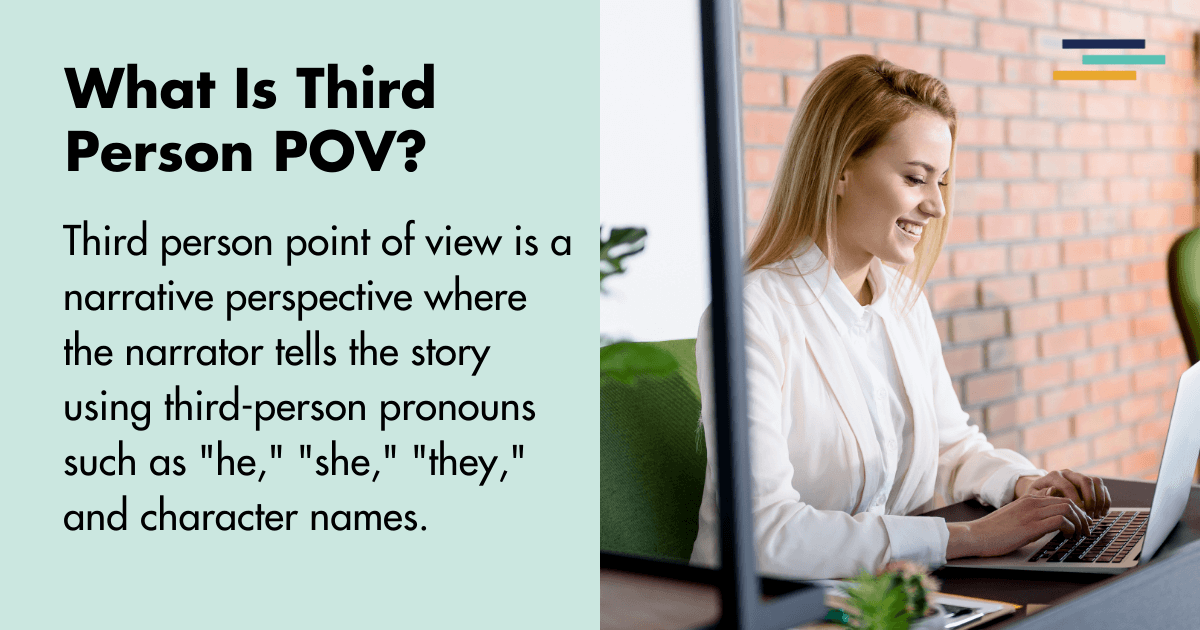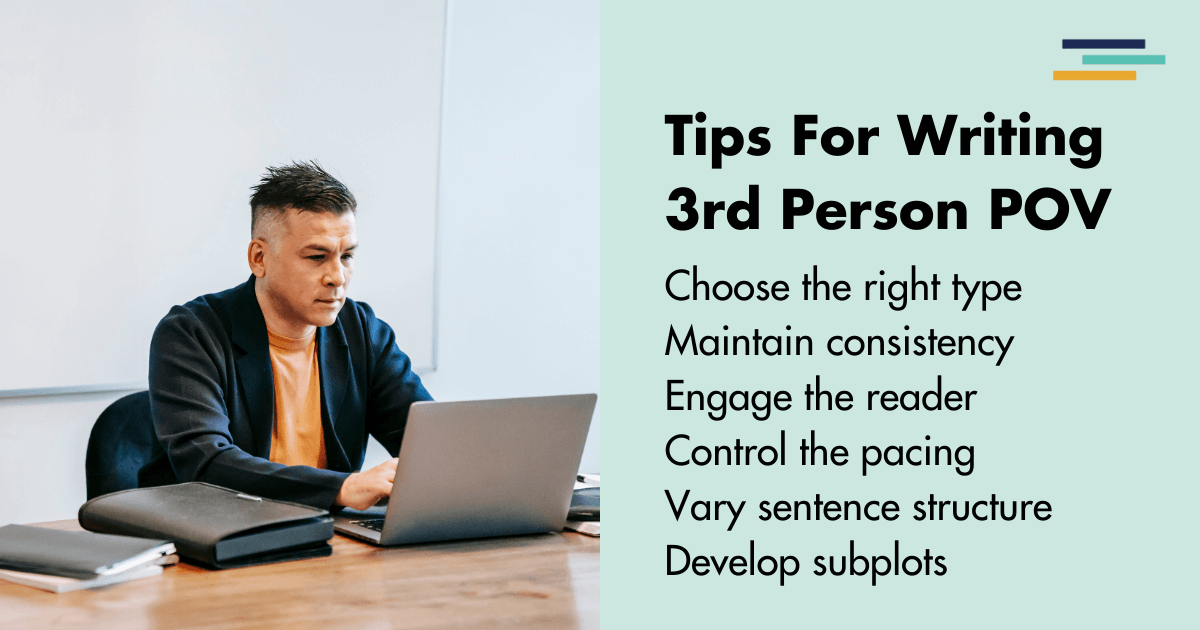
Understanding the various points of view (POVs) in literature is crucial for any writer. One of the most commonly used is the third person point of view, and I might be biased, but it’s one of my favourites to read.
This POV can offer a wide range of storytelling possibilities, giving writers the flexibility to explore different characters and settings in depth.
In this article, we’ll dive into what the third person point of view is, the different types of third person POV, and how to use them in your writing.
Excited? You should be.
Writing from a third person perspective allows the author to step back from the narrative, offering a broader scope of the story’s events and characters. This can be useful in complex stories with multiple characters and subplots. The third person POV can help create an objective tone, presenting the story without the bias that comes from a first person narrator.
In third person point of view, the narrator is not a character within the story, but an external observer.
The narrator can describe scenes, actions, and characters from an outside perspective, which can be useful for revealing information that the characters themselves might not know.
How handy is that?
What Is Third Person Point of View?
Third person point of view is a narrative perspective where the narrator tells the story using third-person pronouns such as “he,” “she,” “they,” and character names.
Unlike the first person POV, where the narrator is a character within the story, normally the protagonist, the third person narrator stands outside the events being described. This detachment allows the narrator to present a broader perspective of the story world.
In third person POV, the narrator can offer a wide lens on the story’s events, providing insights and details that may not be available to a first-person narrator.
This can help create a richer, more layered story, as the reader can see different aspects of the narrative from multiple angles. This perspective can also help build suspense, as the narrator can provide hints and foreshadowing the characters themselves might not be aware of.
And who doesn’t love a bit of foreshadowing?
Third person narration can be useful in genres such as fantasy and science fiction, where the author needs to build a complex world with its own rules and logic.
By stepping outside the characters, the narrator can provide exposition without breaking the flow of the story. Third person POV can help create a sense of objectivity, making the narrative feel more reliable and trustworthy to the reader.

Types of Third Person
When writing in third person, authors can choose from three distinct types:
- Objective
- Limited
- Omniscient
Each type offers unique advantages and challenges.
Third Person Objective Point of View
In third person objective, the narrator reports only what they can see and hear, without access to the thoughts or feelings of the characters. This POV is like a camera recording events without commentary or interpretation. It leaves much for the reader to infer, creating an air of mystery and allowing for greater reader engagement.
This type of POV can be effective in creating suspense and tension.
By presenting only the external actions and dialogue, the narrator forces the reader to piece together the underlying emotions and motivations of the characters. This can create a more engaging and interactive reading experience, as the reader must actively interpret the clues provided by the narrator.
However, third person objective can also be challenging to write.
It requires the author to convey character emotions and motivations solely through actions and dialogue. This can be difficult in scenes where the characters are experiencing complex or subtle emotions.
To effectively use this POV, authors need to be skilled in creating vivid, detailed descriptions that convey the information without specifying it.
Third Person Limited Point of View
Third person limited focuses on the experiences and thoughts of a single character.
The narrator can delve into this character’s inner world, providing insight into their motivations and emotions. However, you limit the narrative to what this character knows and perceives, which can help maintain suspense and build a strong connection between the reader and the character.
This type of POV allows for a deep exploration of a character’s inner life, creating a more intimate and personal narrative.
The reader can see the world through the character’s eyes, experiencing their thoughts, feelings, and perceptions firsthand. This can help build empathy and understanding for the character, making their journey more interesting and relatable.
However, third person limited also has its limitations.
Since you confine the narrative to a single character’s perspective, the reader only knows what this character knows.
This can create challenges in conveying information that the character is not aware of. The author must be careful to maintain the character’s voice and perspective consistently throughout the narrative
Third Person Omniscient Point of View
The third person omniscient narrator has an all-knowing perspective, with access to the thoughts, feelings, and experiences of all characters.
This type of POV allows the narrator to provide a comprehensive view of the story, jumping between different characters and settings. It can offer rich, layered storytelling but requires careful management to avoid overwhelming the reader with too much information.
This type of POV provides the greatest flexibility for the author, allowing them to explore multiple characters and subplots in depth.
The narrator can provide insights into the motivations and emotions of different characters, creating a more complex and nuanced narrative. The omniscient narrator can also provide exposition and background information, helping to build a rich and detailed story world.
However, third person omniscient also comes with its own challenges.
The author must be careful to manage the flow of information, ensuring that too many perspectives and details don’t overwhelm the reader. The omniscient narrator can sometimes create a sense of detachment, making it harder for the reader to connect with the characters on a personal level.
To effectively use this POV, authors need to balance the different perspectives and maintain a clear, cohesive narrative voice.
Examples of Different Types of Third Person
To better understand these POV types, let’s look at some examples from literature.
Third Person Objective Examples
In Ernest Hemingway’s Hills Like White Elephants, the third person objective POV is used to great effect. The narration is sparse, focusing solely on dialogue and actions, leaving readers to infer the underlying tensions and emotions:
“’What should we drink?’ the girl asked. She had taken off her hat and put it on the table.
‘It’s pretty hot,’ the man said.
‘Let’s drink beer.’
‘Dos cervezas,’ the man said into the curtain.
‘Big ones?’ a woman asked from the doorway.
‘Yes. Two big ones.’”
This style keeps readers at a distance, encouraging them to read between the lines.
Third Person Limited Examples
J. K. Rowling’s Harry Potter series predominantly uses third person limited, focusing on Harry’s perspective. This allows readers to experience the magical world through Harry’s eyes, deepening their connection with him:
“Mr and Mrs Dursley, of number four, Privet Drive, were proud to say that they were perfectly normal, thank you very much. They were the last people you’d expect to be involved in anything strange or mysterious, because they just didn’t hold with such nonsense.”
Here, the narrative is confined to Harry’s experiences and feelings, providing a personal and immersive view.
Third Person Omniscient Examples
Leo Tolstoy’s War and Peace is a classic example of third person omniscient.
The narrator provides insights into the thoughts and feelings of multiple characters, offering a panoramic view of the story:
“These words were spoken (in French) one evening in July 1805 by the well-known Anna Pavlovna Scherer, maid of honour and confidante of the Empress Maria Fyodorovna, as she welcomed the first person to arrive at her soirée, Prince Vasily Kuragin, a man of high rank and influence.”
This all-knowing perspective allows Tolstoy to explore the intricate dynamics of a large cast of characters.

Tips For Using Third Person Point of View
Using third person POV effectively requires careful consideration of your story’s needs and the experience you want to create for your readers. Here are some tips:
- Choose the Right Type: Consider whether the detachment of third person objective, the intimacy of third person limited, or the breadth of third person omniscient best serves your story.
- Maintain Consistency: Avoid shifting between different third person POVs within the same narrative unless you have a clear and purposeful reason.
- Develop Characters Clearly: Even in third person, ensure your characters are well-developed and their actions and motivations are clear to the reader.
- Balance Information: In third person omniscient, be mindful not to overwhelm the reader with too much information at once. Provide insights gradually to maintain interest and clarity.
- Engage the Reader: Use descriptive language and vivid imagery to draw readers into the world you’re creating.
- Show, Don’t Tell: Even in third person, aim to show character emotions and motivations through actions and dialogue rather than simply telling the reader.
- Use Dialogue Effectively: Dialogue can be a powerful tool in third person narratives. Use it to reveal character traits, advance the plot, and provide exposition.
- Control the Pacing: Use the flexibility of third person POV to control the pacing of your story. Slow down to provide detailed descriptions and speed up during action scenes.
- Create Foreshadowing: The broader perspective of third person POV allows you to plant hints and foreshadow future events, building suspense and intrigue.
- Maintain a Clear Narrative Voice: Ensure that the narrative voice is consistent and clear, whether you’re using a detached, objective tone or a more intimate limited perspective.
- Use Descriptive Language: Paint vivid pictures with your words to help readers visualize the settings and characters. This can make your story more immersive.
- Vary Sentence Structure: Keep your writing dynamic by varying the length and structure of your sentences. This can help maintain reader interest and convey different moods.
- Develop Subplots: Third person POV can be effective for developing subplots. Use the flexibility of this perspective to explore different storylines and how they intersect.
- Explore Multiple Characters: In omniscient POV, take advantage of the ability to delve into multiple characters’ thoughts and experiences to create a richer narrative.
- Use Symbolism and Imagery: Enhance your storytelling with symbolism and imagery, which can add depth and layers of meaning to your narrative.
And finally, always remember that story comes first. Focus on:
- Creating engaging characters
- Penning interesting plots
- Structuring solid settings
A tool like Fictionary helps you turn your draft into an interesting story readers love. So, with a strong narrative foundation, your writing can truly shine.


